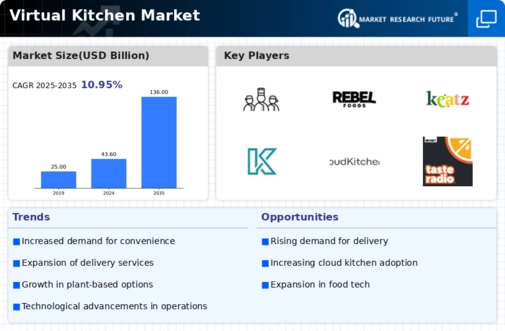Market Share
Virtual Kitchen Market Share Analysis
Companies in the highly competitive Virtual Kitchen market compete based on their differentiation, each offering unique and innovative features that make them stand out from everyone else. This could include offering a variety of dishes and experiments in flavors, incorporating cutting-edge technology for the best user interface, or adopting green practices to satisfy eco-aware consumers. In addition, companies frequently pursue cost leadership strategies to capture a larger share of the market.
This means improving efficiency in production, designing leaner supply chains and striking good deals with suppliers to reduce the total costs of making things. Setting prices competitively while maintaining quality can help companies secure a wider customer base and an important slice of the virtual kitchens pie. Partnerships and collaborations play an important role in the positioning of market share within Virtual Kitchen, too. Making use of existing customer resources: Companies can establish strategic alliances with popular food delivery platforms, and thus to widen their coverage scope.
Furthermore, you can also collaborate with top chefs or culinary influencers to enhance your credibility and reach a wider audience. Apart from providing consumers with a fresh take on virtual kitchen offerings, such collaborations are also helpful in building consumer trust. In addition, companies actively spend on marketing and branding to secure a firm market position. Branding works Not only does this set a virtual kitchen apart, it also makes consumers more likely to remember and recognize the brand. Social media campaigns, influencer marketing and targeted advertising are essential to hit the target audience.
Digital platforms enable virtual kitchens to interact directly with consumers, receive feedback and refine their strategies according the zeitgeist' of every market. Changing consumer preferences pose a big challenge for building up market share in the Virtual Kitchen Market. Consistent market studies keeps firms abreast of changes in tastes and dietary habits, allowing them to revise their menus. Responsiveness to consumer wants not only attracts new customers but promotes loyalty among existing ones.
With the further development of VKMs, data analytics and technology-driven strategies assume greater importance. These companies invest in highly advanced data analysis tools to gain customer behavior, preference and ordering pattern information. The data-driven approach enables virtual kitchens to personalize the menu, optimizing offerings while improving overall customer service.














Leave a Comment